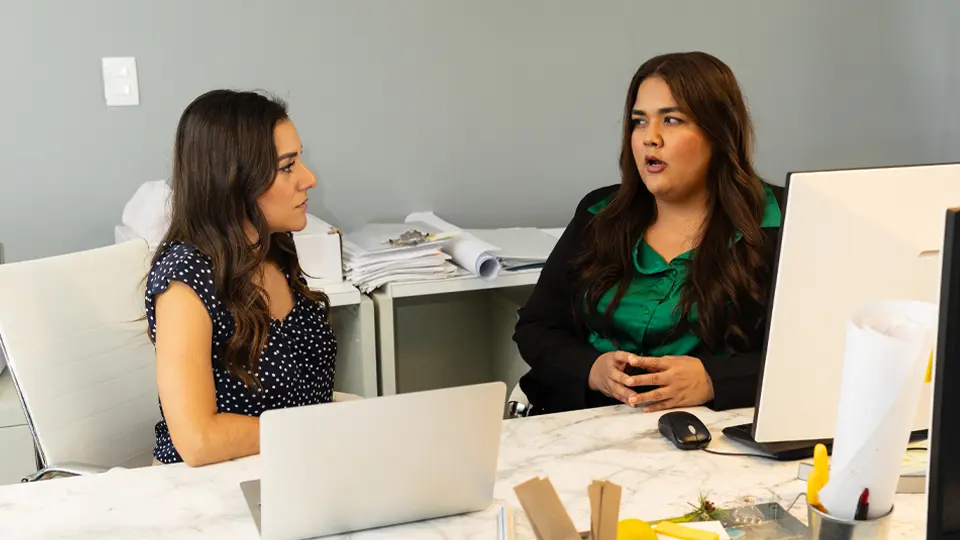Examiners play a critical role in the intellectual property (IP) system, assessing when patent, trademark, geographical indication and industrial design applications can be granted, and upholding the requirements set by laws and international agreements. Each year, they rigorously review, research and determine more than 20 million IP applications. But many of them do far more than this.
Because much of IP examiners’ work is confidential and technical, it is sometimes misunderstood. So, to find out more about what they actually do, WIPO Magazine meets examiners from five IP offices – drawn from across four continents – to discuss their place in the system and how the role of the examiner is evolving.
The role of the intellectual property examiner
The fundamental task of IP examiners is to ensure that IP rights are granted where warranted and that the law is fairly interpreted. This is a big responsibility, as Saima Kanwal, a patent examiner in Pakistan, explains: “My job is to grant due protection that is deserved and to protect the public domain by avoiding unnecessary monopolies in the market.”
For offices that carry out substantive examination of patent applications, that means using the examiner’s experience and the latest tools to make a judgment about whether the invention in the application is novel, non-obvious, and fulfils other criteria that allow it to be patented.
“We’re privileged because we’re learning about innovation before it’s published.”
In the case of trademarks, it means assessing whether a mark is distinctive and whether it affects the rights of third parties. Ana Isabel Varona Guzmán is an examiner of collective trademarks in Colombia. “I learnt to have a critical eye,” she says, “to, for example, see if the trademarks were confusing or if a sign that someone wants to protect as a trademark might affect the rights of third parties or a designation of origin.”
Even in offices that only examine formalities and do not carry out substantive examination of novelty, inventive step and other criteria, examiners have an important role to play. “The formality examination does not just mean that we open the door for everything to be accepted,” says Eno-obong Usen, a senior patent examiner at the Patents Office of the Trademarks, Patents and Designs Registry in Nigeria. “We look through these documents and then interface with the applicants. We tell them more about what intellectual property is and then help those of them who don’t know how to package or how to put their claims together.”

Getty Images/Portra
Much of examiners’ work requires a great deal of curiosity and thoroughness, as well as a comprehensive knowledge of the law. “You’re looking for things; you’re doing a lot of research,” says Xia Wu, an industrial design examiner at the Canadian Intellectual Property Office (CIPO). Fortunately, they do not have to do it alone.
Team effort: why cooperation is key
Examiners do not work solely independently; collaboration is vital. For Usen, every week begins with a 9 a.m. meeting attended by all six patent examiners in the Nigerian office, where they review new applications and share the work between them. Her team also interfaces with trademark and design examiners, she says, so they can better support applicants who may not be sure which IP right is appropriate for them.
“If we see something we’ve never seen before, we share it with the team.”
Margarita Alonzo, a patent examiner who specializes in genetic resources and biochemistry, is one of a team of four in the patents department of the Ministry of Economy in Guatemala. “We usually discuss when we are doing reports for the public health ministry or agriculture ministry, because we need to do that daily,” she says. “We want to be sure that the information we’re sharing is correct and that we’re not violating anyone’s rights, but we also have to be sure that we’re not giving extra rights.”

Getty Images/Antonio_Diaz
“We have regular team meetings to share information and best practices to ensure consistency and quality in our work,” says Wu of her CIPO team. “If we see something we’ve never seen before, we share it with the team and come up with a consistent approach to deal with it.”
Training the next – and current – generations of IP examiners
As well as their duties examining applications, examiners must also dedicate time to training and mentoring juniors, without whom the industry would stagnate.
In Canada, for example, there is a training program for each new cohort of examiners. “Throughout my 18 years here, I’ve coached quite a few trainees,” says Wu, who was awarded the Director General Merit Award for her training and mentoring work. “But the program has evolved over the years. Now they have several weeks of in-classroom training where trainees become familiar with the legislation, followed by many months of coaching and mentoring from senior examiners.”
Many offices benefit from external training from the WIPO Academy, as well as other established IP offices and specialists. Kanwal recalls her 15 days of training early in her career in Pakistan by examiners from IP Australia, as well as more recent training from the Danish Patent and Trademark Office, focused on biotechnology. She also commends the “customized and focused training” given by a member of the Patent Cooperation Treaty (PCT) International Cooperation Division of WIPO.
In Guatemala, Alonzo highlights the e-learning training provided by the WIPO Academy, among others, from which many Latin American offices have benefited. In Nigeria, Usen points to training from provided by examiners from Japan, China and the United States, as well as from the European Patent Office (EPO) and WIPO. “I think the online learning courses really do contribute a lot,” she says, “and we made it compulsory for younger examiners, so they will have full knowledge of what the work entails.”
Junior examiners are not the only ones who benefit from coaching. Ongoing training is important for examiners at all levels because, while the fundamentals of their role have remained consistent, their day-to-day work has changed over the past two decades, in part due to new technologies and in part to legal reforms.

Getty Images/FatCamera
For Alonzo, the biggest changes have been the adoption of the PATENTSCOPE Database and the accession to the PCT by Guatemala in 2006. In her field of biotechnology, she says the next big change will be the implementation of the Treaty on IP, Genetic Resources and Associated Traditional Knowledge approved last year.
In Nigeria, Usen says that the number of patent applications has increased from about 500 a year in 2006 to more than 2,000 a year today. To keep up with the workload, examiners have had to get to grips with new computerization and online tools, many of which require additional training.
For design examiners, technology has improved not only their ability to search prior art but also the speed of their examinations – and, for many designers whose products have a short lifespan, speed is of the essence. “Many years ago we dealt with paper files, and for applications with 300 drawings we were literally putting the pages on the big table in the boardroom,” says Wu. Today, applications are filed and responses sent electronically, and can be received instantly. “It’s reduced the turnaround time by a lot.”
Accessibility: promoting IP for everyone
As well as examining applications and training, IP examiners often work to promote awareness of the IP system and make it more accessible to diverse groups.
In Nigeria, patent examiners have helped to build capacity in universities through the creation of Technology and Innovation Support Centers (TISCs), and meet once a month to discuss outreach and to review the outcomes. “We talk to some of the universities that don’t have intellectual property in their curriculum, or as part of the course in their law faculty,” says Usen. “We also help to establish IP clubs in different universities. The aim is to enlighten the university community and to get more lawyers offering IP as an elective in their universities, while educating science and engineering students on IP.”
“IP is not just about protecting the rights of multinational companies but also supporting local inventors.”
Kanwal has led projects to establish 48 TISCs in Pakistan and worked on a platform for women inventors. “We have a dedicated helpline for women entrepreneurs and inventors, and provide them with mentorship through that platform,” she says. “Instead of just sitting at a desk, I’m now interacting with international partners and stakeholders. Awareness and advocacy are among the responsibilities of all patent examiners in my office.”
She has also written a framework on strengthening the IP and commercialization efforts of higher education institutions in Pakistan. This work contributed to an increase in national patent applications in Pakistan from 20 to around 50 percent. “Through projects such as the inventor assistance program, we can hold their hands and give them one-on-one mentorship,” says Kanwal, who stresses that the rising awareness demonstrates that the patent system is “not just about protecting the rights of multinational companies but also supporting local inventors and entrepreneurs”.
In Guatemala, Alonzo also has a special interest in access to local genetic resources and IP. “I come from an area that is very diverse and has a lot of biodiversity and Mayan culture interacting.” She explains that she learned the importance of genetic resources and traditional knowledge through the natural remedies of her grandmother.
Protecting heritage and community through IP rights
Awareness of local heritage protection and its impact on communities is growing. During the Covid-19 pandemic, Alonzo helped create the Guatemalan chapter of the Organization for Women in Science for the Developing World, engaging with scientists in the diaspora. The organization runs free events to promote science and talks to girls all over the country. “I know I am privileged but I don’t want to be the exception,” she says. “I want every girl, or at least more girls, to have the opportunities that I had to go to university and study STEM subjects.” She has also helped Indigenous women explore how to protect textiles.

Getty Images/Kryssia Campos
Specializing in collective trademarks, certification rights and designations of origin, Varona Guzmán has worked closely with local communities in Colombia. “Part of my work has involved raising awareness among communities and teaching them useful tools to protect their products or services,” she says. “It also involves extensive reading and contact with other government agencies on technical matters that, as a lawyer, I don’t have the capacity to handle and understand.”
Over the past 13 years, Varona Guzmán has witnessed the improvement in legal provisions and accessibility, plus growth in the protection of agricultural and community products. “Through our work, we’ve added value to products that, while well-known, weren’t given much credit until they achieved the award, for example, of a designation of origin. We’ve also helped communities understand that they carry a right but also several responsibilities.”
Reaping the benefits of IP examination
The work of examiners continues to evolve in line with innovative technologies, emerging business trends and legal changes. Such revisions ensure that not only will their roles remain relevant but also that they will continue to face interesting challenges and decisions as they work to uphold the integrity of the IP system. The advantages of their work are many and varied, not just for applicants but for the examiners themselves.
For Wu, the benefits include seeing designs that she has examined in the shops. For Kanwal, it was hearing about vaccines that she had examined going on to save lives during the COVID-19 pandemic.
“It was really worthwhile to feel that somewhere I had contributed to these applications before coming to the market,” she says. “I think we’re privileged because we’re learning about innovation before it’s published,” says Alonzo. “But you also have the responsibility to encourage the innovation system.”
This iswhy, even though many of them did not plan a career in IP, examiners find their work fulfilling and rewarding. As Usen says, as an examiner, you are always learning something new. “As I heard a lecturer say once: when it comes to IP, the closer you get, the warmer it becomes.”
The Empowering and Celebrating IP Examiners project launched in January 2025 and culminated in a celebration of IP examiners throughout November 2025. All interviewees were part of the Changemakers Gallery and were nominated by their national IP offices.

